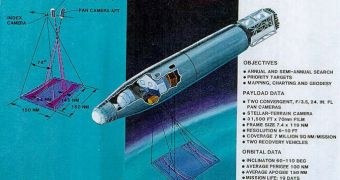On August 18, 1960, the United Sates recorded a massive success, when an airplane managed to recover the capsule of a Corona satellite that had been launched to survey enemy territories.
Developed by the Central Intelligence Agency (CIA) in collaboration with the US Air Force (USAF), the satellite was the first American-built spacecraft to successfully capture photographs from Earth's orbit, using an onboard panoramic camera system.
The machine was unable to send the data straight back to Earth, as it did not have any communications equipment. Rather, it dropped a capsule containing the photos into the ocean, from where it was recovered.
The National Reconnaissance Office (NRO) and National Geospatial-Intelligence Agency (NGA) today celebrated the 50-year anniversary of this first success of the Corona satellite.
Officials from the major defense, space and aeronautics contractor Lockheed Martin congratulated the two American institutions on this impressive achievement, which ushered in a new era of Earth observations for the United States.
The first usable Corona photos were collected from a capsule that was recovered in mid-flight via a C-119 airplane of the USAF. Of the 144 Corona satellites launched, 102 produced usable images.
“The successes achieved by the Corona team were monumental in protecting our nation and advancing aerospace technology,” explains the executive vice-president of Lockheed Martin Space Systems Company, Joanne Maguire.
“Having worked with our government partners on such a vitally important ground-breaking program is a source of tremendous pride for the team,” she adds, quoted by Space Fellowship.
“Corona paved the way for far more sophisticated systems that today are providing unprecedented new capabilities for both government and commercial customers around the globe,” the Lockheed official says.
The company played a critical role in the development of the first successful Corona satellite, through the heritage company Lockheed Missiles & Space Company, The entity was awarded the prime contract for the satellites in 1956.
Overall, the program produced 2.1 million feet of film, and some 800,000 pictures over 12 years. The data was used at a time when US-Soviet Union relationships were chilly at best.

 14 DAY TRIAL //
14 DAY TRIAL //